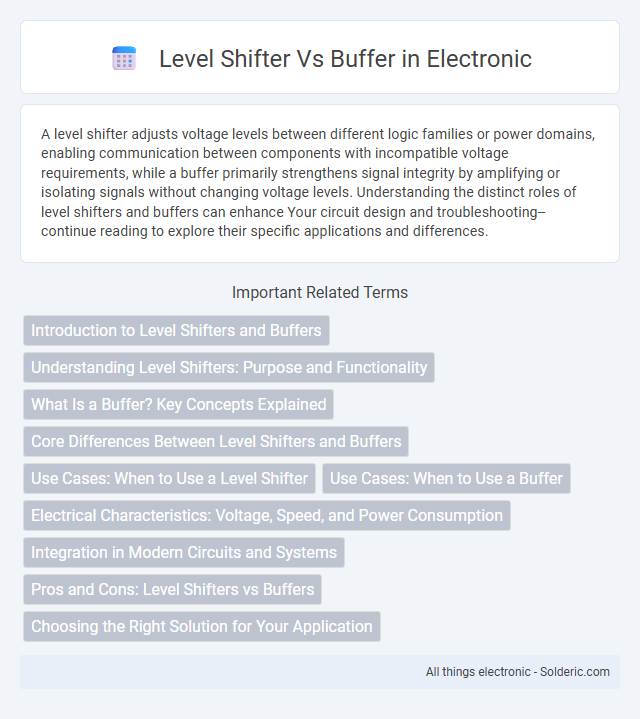A level shifter adjusts voltage levels between different logic families or power domains, enabling communication between components with incompatible voltage requirements, while a buffer primarily strengthens signal integrity by amplifying or isolating signals without changing voltage levels. Understanding the distinct roles of level shifters and buffers can enhance Your circuit design and troubleshooting--continue reading to explore their specific applications and differences.
Comparison Table
| Feature | Level Shifter | Buffer |
|---|---|---|
| Primary Function | Voltage translation between different logic levels | Signal isolation and driving capability enhancement |
| Use Case | Interfacing components with different voltage domains (e.g., 3.3V to 5V) | Strengthening signal drive to prevent degradation across long cables or multiple inputs |
| Signal Integrity | Maintains logic level accuracy across voltage domains | Prevents signal loading and improves signal strength |
| Design Complexity | Requires bidirectional or unidirectional voltage translation circuits | Simple digital circuit, typically single-directional |
| Typical Components | Level shifter ICs, MOSFET-based circuits | Logic buffer ICs (e.g., 74HC series) |
| Voltage Domains Supported | Multi-level (e.g., 1.8V, 3.3V, 5V) | Same voltage domain |
| Directionality | Unidirectional or bidirectional | Primarily unidirectional |
| Application Examples | Microcontroller to sensor communication across voltages | Driving LEDs, signal buffering in digital logic circuits |
Introduction to Level Shifters and Buffers
Level shifters enable signal voltage translation between different logic levels in mixed-voltage circuits, ensuring compatibility and preventing damage. Buffers primarily provide signal isolation and drive strength to maintain signal integrity over long distances or through multiple loads. Both components play critical roles in advanced digital designs by addressing voltage variation and signal quality challenges effectively.
Understanding Level Shifters: Purpose and Functionality
Level shifters enable communication between circuits operating at different voltage levels by translating voltage signals to compatible ranges. Unlike buffers, which primarily provide signal amplification or drive strength, level shifters ensure proper logic level compatibility to prevent damage and timing errors. Understanding your system's voltage requirements helps determine when a level shifter is essential for reliable data transfer across diverse components.
What Is a Buffer? Key Concepts Explained
A buffer is an electronic circuit used to isolate different components in a system, ensuring signal integrity by preventing the loading of the preceding stage. It provides current amplification without changing the input voltage level, making it essential for driving high-capacitance loads or long cables. Your designs benefit from buffers by maintaining stable voltage levels and reducing signal distortion, unlike level shifters that adjust voltage levels between different logic families.
Core Differences Between Level Shifters and Buffers
Level shifters and buffers serve distinct functions in digital circuits, with level shifters primarily used to translate voltage levels between different logic families, ensuring compatibility in mixed-voltage systems. Buffers, on the other hand, are designed to amplify or isolate signal strength without altering voltage levels, maintaining signal integrity over long distances or multiple inputs. Understanding these core differences helps you choose the right component for managing signal compatibility and strength in your electronic designs.
Use Cases: When to Use a Level Shifter
Level shifters are essential when interfacing components with different voltage domains, such as connecting a 3.3V microcontroller to a 5V sensor, ensuring safe and reliable communication. Your circuits require level shifters to prevent voltage mismatch damage and maintain signal integrity across varying logic levels. Buffers, in contrast, primarily improve signal drive strength and isolation without voltage translation, making them unsuitable for mixed-voltage applications.
Use Cases: When to Use a Buffer
Buffers are essential in digital circuits when signal integrity needs reinforcement over long distances or through multiple loads, preventing signal degradation and ensuring consistent voltage levels. You use a buffer when driving high fan-out loads, isolating different circuit stages, or matching impedance to maintain proper signal timing. Unlike level shifters that handle voltage domain translation, buffers maintain signal strength within the same voltage level for reliable data transmission.
Electrical Characteristics: Voltage, Speed, and Power Consumption
Level shifters manage voltage differences between circuits, ensuring compatibility across varying voltage domains, typically operating at lower speeds and consuming moderate power due to voltage translation overhead. Buffers enhance signal integrity by driving higher current loads at consistent voltage levels, offering faster switching speeds with relatively low power consumption. Understanding your design requirements for voltage compatibility, switching speed, and power efficiency is crucial when choosing between a level shifter and a buffer.
Integration in Modern Circuits and Systems
Level shifters enable seamless voltage compatibility between different logic families in modern mixed-voltage circuits, ensuring reliable signal integrity across diverse components. Buffers primarily enhance signal drive strength and isolation but do not translate voltage levels, limiting their use in systems requiring cross-voltage communication. Integration of level shifters is crucial in advanced SoCs and IoT devices where multiple power domains coexist, while buffers optimize timing and reduce loading effects within uniform voltage domains.
Pros and Cons: Level Shifters vs Buffers
Level shifters enable seamless voltage translation between different logic levels, ensuring signal integrity in mixed-voltage systems, but can introduce propagation delay and increased complexity. Buffers primarily enhance signal drive strength and isolate stages, improving signal integrity and load driving capability, yet they do not perform voltage translation, limiting use in multi-voltage environments. Choosing between a level shifter and a buffer depends on system voltage compatibility requirements and desired signal conditioning.
Choosing the Right Solution for Your Application
Selecting the right level shifter or buffer depends on your application's voltage compatibility and signal integrity requirements. Level shifters are essential for translating signals between different voltage domains, ensuring proper communication in mixed-voltage circuits. Buffers improve signal drive strength and isolate stages, making them suitable when signal stability or loading issues are the primary concern.
level shifter vs buffer Infographic

 solderic.com
solderic.com